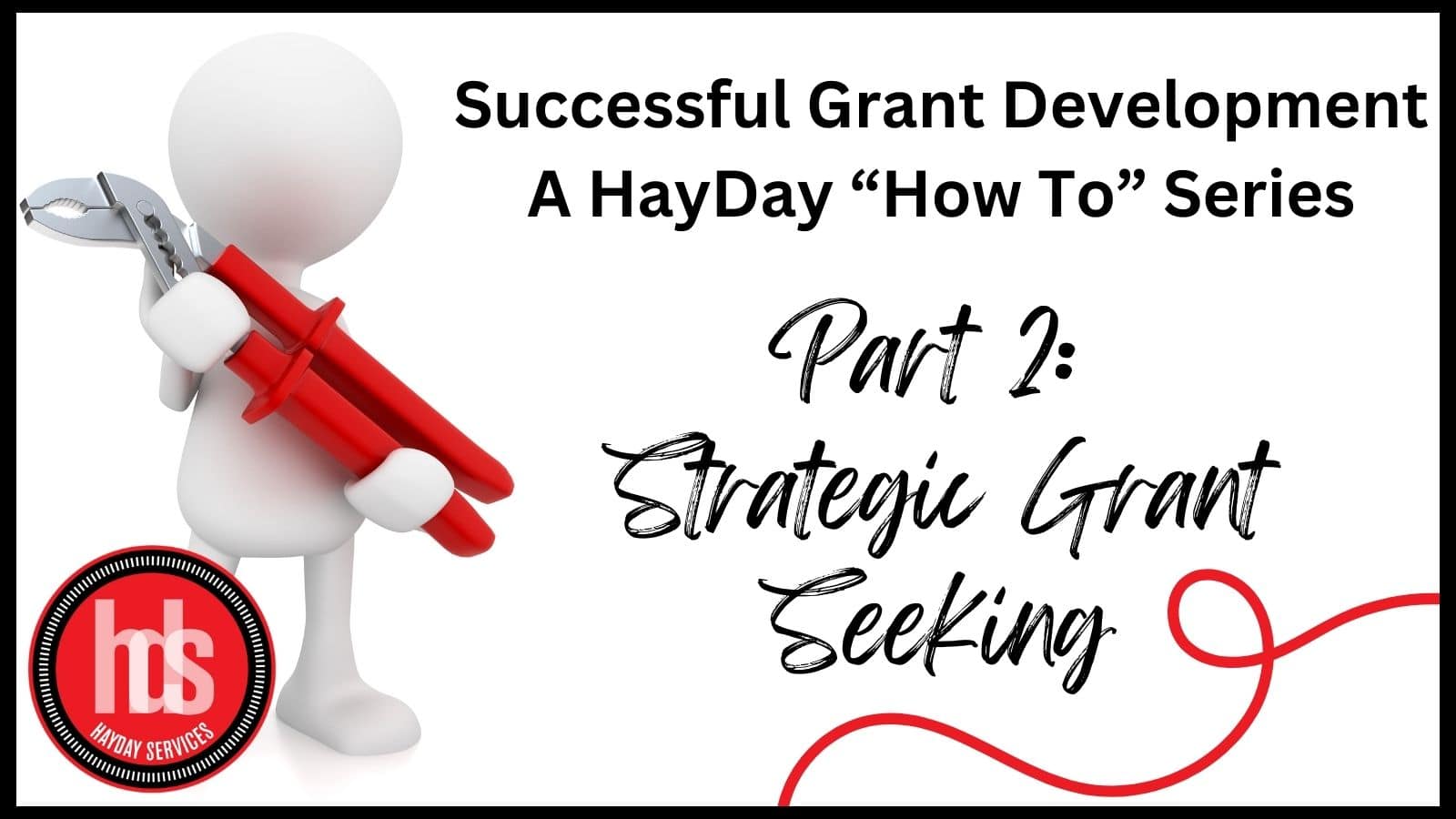HayDay Services is bringing you a series of “how-to” articles related to successful grant development.
Part 2: Strategic Grant Seeking
If I had a nickel for every time someone told me that Mackenzie Scott makes lots of grants, corporations are a great source of nonprofit grants, or that grants are free money—I’d have a foundation with the largest assets and the least painful grant application ever invented.
Until I reach that lofty position (don’t hold your breath), let’s explore how you can enhance your grant-seeking strategy to secure more funding and advance your mission. Whether you’re new to grants or an experienced professional, these strategic grant writing tips will help you boost your nonprofit’s funding potential.
Understanding Strategic Grant Seeking
Strategic grant seeking means aligning your organization’s needs with the right funding opportunities. It involves careful planning, thorough research, and a focused approach to identifying and pursuing grants that are most likely to succeed.
Key Elements of a Strategic Grant Writing Approach
1. Comprehensive Organizational Assessment
2. In-depth Funder Research
3. Relationship Building with Funders
Comprehensive Organizational Assessment
Before looking at grant opportunities, thoroughly examine your organization’s strengths, weaknesses, needs, and long-term objectives. This self-awareness will guide your grant-seeking efforts and help you focus on opportunities that truly align with your mission. Chasing money by applying for grants that don’t fit is a long-term losing game.
In-depth Funder Research
Federal and state grants are much easier to search for free. For efficient private and corporate foundations, paid databases are the best way. But plugging in keywords or foundation names is just the start. When researching potential funders, don’t just focus on the dollar signs. Dive deep into their mission, funding history, and priorities.
Good sources for this information include:
– Foundation websites
– Recent Requests for Proposals (RFPs)
– Notices of Funding Opportunities (NOFOs)
– Grant application guidelines
Look for alignment between their goals and yours. You’ll most likely be asked to write about that alignment in many grant applications. Pay attention to the types of projects they’ve funded in the past and the organizations they typically support.
Building Relationships with Funders
Grant seeking isn’t just about submitting applications. People make funding decisions, whether they’re program officers, trustees, family members, or corporate review committee volunteers. Whenever possible, it’s about building meaningful relationships with funders.
Ways to build relationships:
– Attend funder events
– Engage with funders on social media
– Seek opportunities to connect personally when appropriate
These relationships can provide valuable insights and potentially open doors to funding opportunities. Don’t forget to check with your board members, commissioners, council members, or other staff and volunteers to see if there are any connections to foundations or corporate funders.
Implementing Your Grant Writing Strategy
Once you’ve laid the groundwork, it’s time to put your strategy into action. Here are key steps to implement your grant writing strategy:
1. Create a grant calendar outlining potential opportunities throughout the year.
2. Prioritize your opportunities based on factors like grant size, mission alignment, and potential success.
3. Tailor each proposal to the specific funder, addressing their interests and priorities.
4. Show how your work aligns with their goals and how their investment will transform the communities you serve.
Measuring and Refining Your Grant Writing Approach
Strategic grant seeking is an ongoing process. Regularly evaluate your efforts and refine your approach based on outcomes: – Keep detailed records of your applications, including unsuccessful ones.
– Analyze data to identify trends and areas for improvement.
– Seek feedback from funders, especially on unsuccessful applications.
– Use feedback to strengthen future grant proposals.
The Bigger Picture: Beyond Grant Writing
Remember, strategic grant seeking is just one part of a broader funding strategy. While grants can provide substantial support, they shouldn’t be your sole funding source. A truly strategic approach to nonprofit sustainability involves diversifying funding streams, such as:
– Individual donations
– Corporate partnerships
– Earned income
– Crowdfunding campaigns
By adopting a strategic approach to grant seeking, you’re enhancing your chances of securing funding and positioning your organization for long-term success. You’re cultivating meaningful relationships, improving your ability to communicate your impact, and ensuring that the funding you secure truly advances your mission and objectives.
Frequently Asked Questions About Strategic Grant Writing
1. Q: What is the most important element of strategic grant seeking?
A: The most crucial element is aligning your organization’s mission and needs with the right funding opportunities.
2. Q: How often should I update my grant writing strategy?
A: Review and update your strategy at least annually, or more frequently, if significant changes occur in your organization or the funding landscape.
3. Q: Are paid grant database subscriptions worth the investment?
A: For many organizations, yes. They can save time and provide valuable insights, especially for researching private and corporate foundations.
Ready to take your grant writing strategy to the next level? Check out our 8-week grant writing training course, the Grants Lab.
Kimberly Hays de Muga, GPC, is an expert trainer and coach in nonprofit capacity building, grant writing, fundraising, and board development. She brings more than 25 years of fundraising experience that includes raising $100 million from individuals, foundations, corporations, and local, state, and federal funding for nonprofit agencies in the education, health, and human service sectors—from food banks to pediatric hospitals, to state-wide mental health coalitions.
Latest posts by Kimberly Hays de Muga
(see all)



